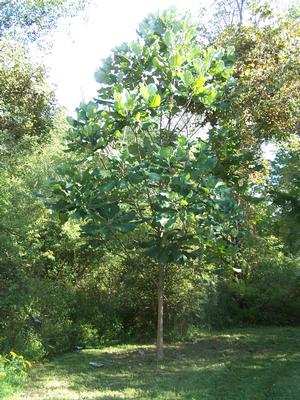View All Plants :: View All TREES
Magnolia macrophylla
Bigleaf Magnolia
Plant Type:
TREESMagnolia macrophylla - The Bigleaf Magnolia. Just think big in all respects... Gigantic bright green ruffled leaves can grow as long as 32 inches and 12 inches wide with a silvery patina on the under sides. They are noticeably grand, almost tropical in appearance. Look at the size comparison to my big paw to a single leaf (see pic). It's easy to make the visual connection to banana leaves save the more rounded leaf ends. And those lighter silvery undersides flashing in summer breezes are eye catching. June cream-white flowers are no slouches either as they expand 8 to 10 inches but may achieve 14 inches in diameter. These hug the branches upon which they perch. Though deliciously fragrant you'll likely have to climb a ladder to sniff the scent. Flowers are comprised of 6 to 9 tepals with the 3 inner petals exhibiting a flush of red-purple like a subtle flame on each. The glorious pink structures holding copious seed are extraordinary, larger than a fist they are 4 to 4+ inches tall. Architecturally they could pass for elegant finials topping the end of a banister at the base of an elegant stairwell. They darken to mauve, split open and display lightly-glossed bean-shaped seeds that are light pink, a pink like 60s vinyl pink (see pic). Seed emergence occurs mid to late October in USDA 5b. The structures that secure and display the seeds remain turning sienna, resembling brown pine cones as the leaves may turn golden brown though are just as likely to get frosted and drop. Persistent, the inflorescence turn black by winter and are noteworthy winter interest sitting erect at branch tips in contrast to the light gray bark. Or harvest them for they are really quite beautiful and can be well-used in wreath making, as woodsy Christmas tree ornaments or fashioned in dry winter arrangements. Magnolia macrophylla var. macrophylla is not a tree for a small landscape; rather, it could be a splendid element, a specimen on a larger property, an estate or in a park setting... as stated at the start: just think big in all respects. It will become a cherished component when well-employed. We are impressed with all of its fine qualities. Fertile moist soil in dappled to part shade. Our very happy specimen, planted in rich bottomland soil, is exposed to full sun. Established potted tree, grown from seed or cutting.
Characteristics and Attributes for Magnolia macrophylla
Season of Interest (Flowering)
- Late Spring
Season of Interest (Foliage)
- Spring / Summer / into Autumn
Interesting Bark
- Smooth
Autumn Interest
- Fruit / Berries / Seed Heads
Nature Attraction
- Butterflies
- Hummingbirds
- Deer Resistant
- Honey Bees & Native Bees
Light
- Full Sun
Attributes
- Specimen
Growth Rate in the Garden
- Moderately Fast
Soil
- Humus Laden
- Organic
- Draining
- Moist
- Fertile
Origins
- Southeastern U.S.
Propagated By
- By Seed / Potted
- Division
Genus Overview: Magnolia
Common Name: Magnolia
The Magnolias are one of the earliest known flowering plants to establish themselves on our beautiful planet. Much breeding continues and the cultivar list is expanding with some smaller sizes and new flower colors. Many are typical tree forms while some tend to be multi-stemmed – more like huge shrubs than single-stemmed trees. Most are spring blooming – some early, others later after danger of frost has passed in the north. A few of these will provide some recurrence of bloom during the summer. A handful bloom in summer. Many emit wonderful fragrance. The foliage is often large, bold and paddle-shaped, looking attractive in summer; a handful of species’ leaves are so large that they are reminiscent of banana foliage. Some seasons they develop gold to golden brown autumn color before the leaves drop. It’s hard for me to think of a landscape without one or more included in the mix. All prefer fertile deep loam with plenty of organic matter and moist soils – some are even content in relatively wet conditions. Magnolias should be sited in full to half sun exposures. All our selections are cutting grown, on their own wood – they are not grafted. Some are much easier to produce on their own wood than others; some are quite recalcitrant. In that, we may not always have certain plants available or available in great numbers. Spring planting is recommended for magnolias especially up north. Cutting grown.


